In yesterday’s post about the progress on my big switch mode supply I mentioned that I was going to try building an Arduino based inductance meter based on the basic and straight forward design from Shadi Soundation.
I built the meter later in the evening. It seemed to work okay, but the numbers seemed odd when used to test some fairly marked inductors I had on hand. Without an actual inductance meter I wasn’t able to compare numbers, of course. The author’s version shown in his video seemed really accurate for what it was.
This may have been because I used an LM324 quad op-amp chip instead of the recommend LM393 which is a dual comparator chip, it’s not surprising things didn’t turn out perfect. Once I get an LM393 I’ll update this post. I really can’t believe I didn’t have an LM393 anywhere in the house. If I had found this Analog Devices application note, I wouldn’t have even attempted it in the first place.
I didn’t have a non-polarized 1uF capacitor so I used 10 * 0.1uf capacitors. When I tested the capacitance with the Fluke it came out right at 1.001uF. In the Arduino code you need to update the capacitor value. He has 95E-8, for 1uf, it just gets changed to 100E-8.
Some things of note: I connected the scope-meter across the inductor under test and it was picking up frequencies in the 15Mhz range along with decent waveforms. I’m not sure why that is, but the scope was locked into the signal pretty solid with some interesting waveforms (sort of a PWM overlaid on a waveform) I’ll post some images tonight of that? (Followup: the 15Mhz signal was riding on the main signal, the scope automatically locked into this waveform at a very low uV/div value and auto-calibrated rather than adjusting to the actual waveform I was looking for at a much higher 1V/div setting.) I also grabbed the frequency counter. I didn’t directly connect it to the circuit, but I attached a small antenna and put it near the inductor and it was reading about 100 to 105 kHz.
With the LM324 Quad Op-Amp, the first picture is my hand wound inductor on the test setup. The second picture is of a commercially wound .86mh inductor under test.
More pictures later with the LM393, waveforms, etc.
Later the next day…
Well I was not able to find an LM393 dual comparator, all I could find was an LM339 quad comparator. I went ahead rebuilt the little circuit around that and tested it. The numbers shifted dramatically. My inductors were now testing out at 298uH or something of the sort (I forgot since I changed it). This seemed weird. I hooked the scope up to the circuit and measured the signal directly of the transformer and got a 9.175khz ‘ring’ off the inductor when the Arduino struck the LC circuit with a pulse of power. The picture below is the inductor ringing.
I also checked the output from the comparator and you can see the square wave it’s putting out in response to the input from the inductor.
I put the values of 9.125 into and 1uF into an online resonant frequency calculator and it told me that at 9.127Khz @ 1uF the inductance of the coil in the circuit should be about 301uH. The software on the Arduino was now saying the inductance is 305uH. Hmm those sound pretty close, so maybe I’m going in the right direction, finally.
Well, this didn’t make sense. The calculator I used had told me that I needed 44.68 turns of 12 Gauge wire (the numbers above are with 45 turns tho) around this Type 26 inductor in order to get 360uH, look below.
But after my latest rounds of attempts I decided to try another inductor core calculator. This one was much simpler. It actually seems targeted to cores like those made by Amidon and specifically had the material type and core size in it’s database. Here’s the output from this other toroid winding calculator.
It’s recommendations are a bit different, saying that 47 turns are required for 350uH instead of 44 turns. I think that’s a little low as well, but getting closer. If at 45 turns I am getting 305uH, then 305/45 = 6.777uH per turn. In order to get 360uH it should be 360/6.777 which comes out to 53 turns, not 47.
Well, at any rate it seems I’m getting closer to a solution. In the end I’m just going to have to buy a somewhat calibrated LCR meter from somewhere to test the inductors and then I’ll feel more secure in this latest batch of information. If you have any ideas or thoughts about this measurement mayhem, let me know.
Update: I borrowed a friends LC meter and it confirms that this inductor is ~300uH, so it seems that the Arduino based tester is ‘pretty close’ and probably good enough for basic stuff, you might need a little more precision if you’re doing RF work though. I added some windings onto the inductors and they’re all good to go. Maybe I should spend a few bucks and get my own LCR meter some day.

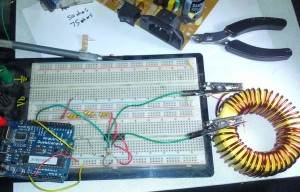
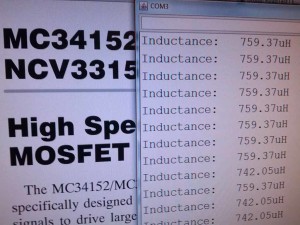
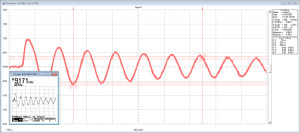
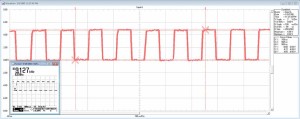
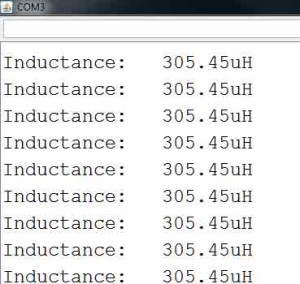
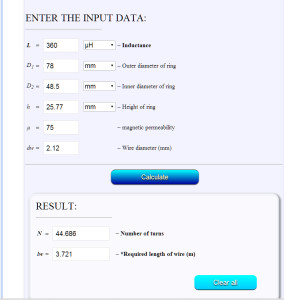
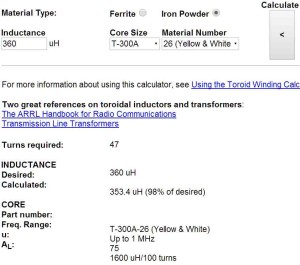
1 responses to Arduino Inductance Testing
Great work and thanks a lot of the reference.
best wishes
Leave a reply to Arduino Inductance Testing